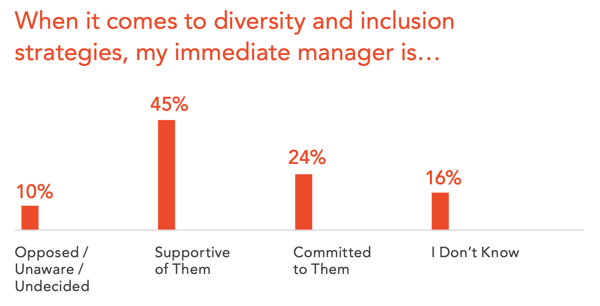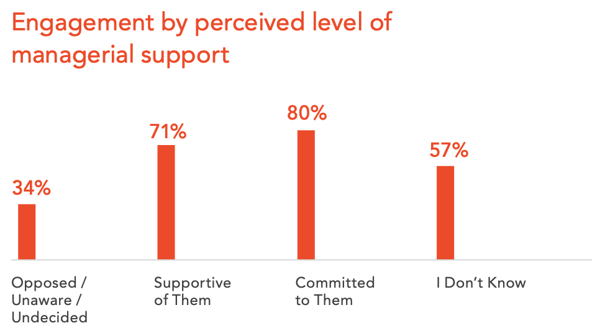
 It’s not enough for organizations to just have diversity and inclusion policies in the workplace. Any organization-wide strategy or initiative needs to be embraced by all employees—especially managers.
It’s not enough for organizations to just have diversity and inclusion policies in the workplace. Any organization-wide strategy or initiative needs to be embraced by all employees—especially managers.
Managers help guide and lead the teams and individuals that make up organizations. If managers aren’t on board with an initiative, teams may suffer—and it’s likely the initiative won’t get very far.
Fostering diversity and inclusion in the workplace involves:
In response to a recent Quantum Workplace survey, employees were asked to finish the following sentence:
"When it comes to diversity and inclusion strategies, my immediate manager is…”
The multiple choice options were based on Deloitte’s six personas of strategic change.

45% of employees believe their immediate managers are supportive of diversity and inclusion strategies in their organizations. An additional 24% believe their managers are committed. This is good news—but it’s not good enough. Here’s why:
26% of employees either think their managers are opposed, unaware, or undecided about diversity and inclusion, or simply don’t know how their managers feel.
This reality has huge implications on employee engagement.
"Delivering a more inclusive employee experience is first and foremost a product of a certain kind of leadership or management," says Joe Gerstandt, Author & Inclusion Strategist.
"Organizations must clearly define the experience they want employees to have. And then you’ve got to build that into your management expectations. Some specific behaviors and practices need to be written into job descriptions."
When employees don’t feel their managers are committed to diversity and inclusion, their engagement suffers. The graph below breaks out perceptions of managerial support by engagement.

Employees who believe their immediate managers are opposed to, unaware of, or undecided about diversity and inclusion strategies are less engaged than employees who believe their managers are supportive of or committed to those strategies. These results underscore the importance of managers in shaping employee perceptions and feelings.
Employees are also less engaged when they don’t know how their managers feel about diversity and inclusion. Being in the dark can potentially hurt engagement.
Managers who are supportive of, or committed to, diversity and inclusion should demonstrate through action when possible. If managers are opposed to, unaware of, or undecided about diversity and inclusion, deeper concerns may need to be addressed before managers share those thoughts with their teams.
Some managers aren’t confident speaking about D&I, but they can still show their commitment in other ways. Examples of this might be:
Setting appropriate diversity goals is a big step toward healthier cultures of inclusion and diversity. However, getting leadership buy-in and commitment is arguably the most critical aspect of this journey. Consider these ideas for encouraging leadership support:
Before you start talking about D&I initiatives, you need to have a clear purpose behind your actions. You need to have a shared understanding of why diversity and inclusion is important to your organization.
Teach leaders about social issues by relying on curated content compiled by experts in the field. It’s not enough to just be aware of the struggles their specific employees face. It’s also important to be knowledgeable about social issues from a wide range of sources and perspectives. This is especially true for leaders of smaller or less-diverse organizations, where a variety of insights might not be readily available.
Educate leaders about the impacts their decisions have on diverse employees across the organization, as well as the challenges those employees face. Use real-life feedback and opinions gathered in focus groups and surveys from employees across the organization to fuel these conversations.
There are variety of ways you can begin to foster a diverse and inclusive culture. But until you put it into practice, it’ll be hard for managers to understand how they can make an impact. Allow managers to put together cross functional teams to make decisions and problem solve as a unit. Hearing from a variety of voices and experiences will allow your employees to tackle workplace issues together. This gives managers the opportunity to reinforce the importance of understanding everyone’s perspectives while building team morale.
Gerstandt describes unintentional bias as the automatic assignment of thought without awareness, intention, or control. He says, "These thoughts aren’t things we know, they are things we think we know."
But the real power comes from being able to acknowledge those thoughts and choose to do something different.
Helping managers become aware of their own biases can help them better focus on and improve employee matters. Coach managers to address their employees with these things in mind. When a thought enters their mind, they should stop and think:
If you want to truly tackle D&I within your teams, you need to be direct. While the heavier conversations aren’t always the easiest, they are sometimes the most important ones to have. This often requires incredible tact and work to prepare.
Find out what’s going on within your organization and address those items head on. Don’t skirt around real issues just because you feel uncomfortable. Determine what needs to be discussed and make them a priority.
You don’t need to implement a company-wide initiative to begin making an impact on D&I. If you’re not sure where to start, begin at the individual level. Start asking your employees questions to get to know them better. Uncover personality traits, behaviors, expectations, and experiences to understand why they aren’t all wired all the same.
Being a manager sometimes requires a need to be vulnerable with employees. But to really influence an inclusive atmosphere, managers must feel like HR is a resource as well. After you’ve rolled out training or provided resources for your managers, make sure HR and senior leadership is available to follow-up on any missing pieces.
Managers often feel like they can’t make mistakes because of their position. But we’re all human, and we all make mistakes. And mistakes help us grow. When we learn from our mistakes, we have more capacity to open our hearts and minds to others. Show your managers that it’s okay to mess up by:
You can’t overstate how important early leadership buy-in is to organizational initiatives, like creating a more diverse and inclusive workplace. And inclusive behavior is more impactful than inclusive programs. If you lead by example, people are more likely to follow in your footsteps. Demonstrate inclusivity by:
Improving diversity and inclusion in your organization is not an overnight occurrence. D&I is a complex topic that impacts every individual. It may not feel like you are making immediate progress in your efforts, but it’s important to take time to slow down and think.
To learn more about how you can ensure managers are equipped to support your D&I efforts, download our latest research, Diversity and Inclusion in the Workplace.
Published February 25, 2020 | Written By Anne Maltese